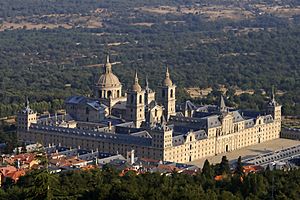Spanish Renaissance facts for kids
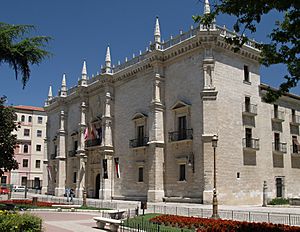
The Spanish Renaissance was a period in Spain when new ideas in art, literature, and science became popular. It started in Italy in the 1300s and came to Spain in the 1400s and 1500s. This movement was inspired by the ancient Greek and Roman cultures.
Several big events in 1492 helped the Renaissance grow in Spain:
- Spain became one Christian kingdom after taking Granada, the last Muslim-controlled area. Sadly, many Muslim and Jewish people were forced to leave Spain.
- Christopher Columbus officially discovered the Americas.
- The first grammar book for the Spanish language, called Gramática, was published by Antonio de Nebrija.
Contents
How the Spanish Renaissance Began
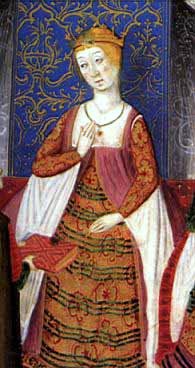
The start of the Renaissance in Spain is closely tied to the rule of the Catholic Monarchs, King Ferdinand and Queen Isabella. They were the first to move away from older medieval ways. In the past, kings were often weak, and powerful nobles caused trouble.
The Catholic Monarchs brought together the country's power. They also made alliances with important noble families to keep their control. One family, the Mendoza, used the new Renaissance style to show their importance and their support for the monarchy.
Over time, this new artistic style spread to the royal court and the Church. It mixed with Spanish styles, like the art from the kingdom of Granada and the unique Gothic style of Castile. It also blended with Flemish art, which was popular in official court and Church paintings. This mix of styles created a special Spanish Renaissance look called Plateresque.
Artists from Italy came to Spain, and Spanish students went to Italy to learn. They brought back designs, building plans, books, and paintings. Spanish artists then copied these ideas, including portraits, themes, and how to arrange a scene.
King Charles I (who was also Charles V of the Holy Roman Empire) really liked this new art, which was sometimes called "the old way" because it looked back to ancient times. He supported many artists directly. For example, he commissioned works from Titian, a famous Italian painter, though Titian never moved to Spain.
Other talented painters, not always close to the royal court, included Pedro Berruguete, Juan de Juanes, and Paolo da San Leocadio. One beautiful painting is the Virgin of the Caballero de Montesa by Paolo da San Leocadio.
Painting and Sculpture in the Spanish Renaissance
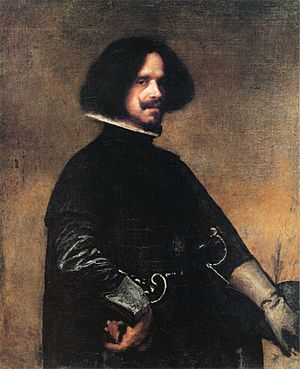

Spanish Renaissance paintings were usually made with oil paints. Artists created indoor scenes that followed the rules of perspective, making them look realistic. People in the paintings were all the same size and looked anatomically correct.
Colors and shading were used in different tones, following Italian methods. To make the paintings feel even more Italian, artists often added elements copied directly from Italian art. These included a candelieri decorations (borders with plants and small angels) or Roman ruins in the backgrounds, even in scenes about the life of Christ.
Famous Painters
- Pedro Berruguete
- Alonso Berruguete
- Alonso Cano
- Juan de Flandes
- Fernando Gallego
- El Greco
- Luis de Morales
- Juan Pantoja de la Cruz
- Alonso Sánchez Coello
- Sofonisba Anguissola
- Fernando Yáñez de la Almedina
- Bartolomé González y Serrano
- Diego Velázquez
Key Paintings
- The Burial of the Count of Orgaz by El Greco
- The Nobleman with his Hand on his Chest by El Greco
- Laocoön by El Greco
- Annunciation by Pedro Berruguete
- Pieta by Fernando Gallego
- Portrait of Isabel Clara Eugenia by Alonso Sánchez Coello
- Virgin of the Milk or Virgin with Child by Luis de Morales
Important Sculptors
- Juan de Ancheta
- Gaspar Becerra
- Alonso Berruguete
- Felipe Bigarny
- Damià Forment
- Esteban Jordán
- Juan de Juni
- Bartolomé Ordóñez
- Diego Siloe
Architecture in the Spanish Renaissance
Spanish Renaissance architecture often mixed traditional Spanish styles with new ideas from Italy. Buildings became grander and more balanced.
Key Architects
- Juan de Herrera
- Juan Bautista de Toledo
- Gil de Hontañón
- Diego Siloe
- Enrique Egas
- Alonso de Covarrubias
- Pedro Machuca
- Andrés de Vandelvira
- Diego de Riaño
- Juan de Álava
- Hernán Ruiz the Younger
Literature of the Spanish Renaissance
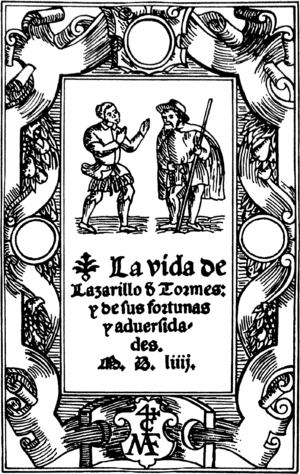
The Renaissance brought many new ideas to Spanish literature, including poetry, plays, and novels. Writers explored human feelings and experiences.
- Miguel de Cervantes Saavedra, famous for El Ingenioso Hidalgo Don Quijote de la Mancha
- Jorge Manrique, known for Coplas por la muerte de su padre
- Garcilaso de la Vega, a well-known poet.
- San Juan de la Cruz and Santa Teresa de Jesús, who were mystic poets.
- Fernando de Rojas, author of La Celestina
- Fray Luis de León
- Juan Boscán
- Ausiàs March
- Alonso de Ercilla, who wrote La Araucana
- Lope de Rueda
- Fray Luis de Granada
- Marqués de Santillana
- Diego Hurtado de Mendoza
- Juan Latino, a poet and scholar.
- Anonymous writers of the Romancero (a collection of ballads) and the famous picaresque novel Vida de Lazarillo de Tormes.
Music in the Spanish Renaissance
Music also flourished during the Spanish Renaissance, with many composers creating beautiful works for voices and instruments.
- Arpa de dos ordenes (a type of Spanish harp)
- Juan de Anchieta
- Antonio de Cabezón (an organist)
- Juan del Encina (also a poet and playwright)
- Bartolomé de Escobedo
- Juan de Esquivel Barahona
- Juan Pérez de Gijón
- Francisco Guerrero
- Mateo Flecha
- Alonso Lobo
- Luis de Milán (a vihuelist, playing a stringed instrument like a guitar)
- Cristóbal de Morales
- Alonso Mudarra
- Juan Navarro
- Diego Ortiz
- Francisco de Peñalosa
- Joan Pau Pujol
- Melchior Robles
- Francisco de Salinas (a music theorist)
- Tomás de Santa María
- Francisco de la Torre
- Juan de Triana
- Juan Vásquez
- Tomás Luis de Victoria
- Sebástian de Vivanco
- Luis de Narvaez
Science and Learning
The Renaissance was a time of new discoveries and ideas in science and learning.
- Miguel Servet
- School of Salamanca (a group of scholars who studied law, economics, and theology)
- Jerónimo Muñoz
- Fernán Pérez de Oliva
See also
 In Spanish: Renacimiento español para niños
In Spanish: Renacimiento español para niños
- Spanish art
- Renaissance of the 12th century
- Portuguese Renaissance
- Al-Andalus


